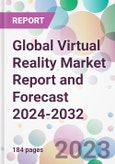According to the report, the global virtual reality market grew substantially in the historical period. Aided by the increasing demand for immersive gaming and entertainment experiences and the arrival of 5G, the market is projected to grow at a CAGR of 14% between 2024 and 2032 to grow significantly by 2032 reaching a value of approximate USD 68.3 billion by 2032.
Virtual reality refers to a computer-generated simulation in which a user can interact with an artificial three-dimensional environment using electronic devices, such as VR goggles or gloves fitted with sensors. As technological horizons expand, VR stands out as a paramount facet, reshaping entertainment, gaming, healthcare, and education by offering experiences that blur the line between reality and the digital realm.
The surging demand for immersive gaming and entertainment experiences acts as the primary catalyst driving the virtual reality market growth. With gaming enthusiasts seeking realistic, interactive, and 3D gaming experiences, VR has quickly risen to meet these demands, offering unparalleled levels of engagement. Major tech and gaming enterprises are pouring resources into VR research and development, heralding a new era in digital gaming dynamics.
Beyond the realm of entertainment, VR's transformative potential is evident across diverse sectors. In the healthcare industry, virtual reality market demand is witnessing a surge to execute surgical training, patient treatment, and rehabilitation. Medical professionals can use virtual simulations to hone their skills, ensure precision during surgeries, and provide therapeutic interventions for conditions like PTSD or phobias. In the realm of education, VR creates dynamic and interactive learning environments, enabling students to explore complex concepts in an immersive setting, thus fostering better comprehension and retention.
Another pivotal domain for VR is the real estate and architectural sector. Virtual property tours provide prospective buyers with an authentic feel of the property, irrespective of their geographic location. This not only optimises the buying experience but also streamlines the sales process for realtors.
The integration of AI with VR promises an even more personalised and intelligent virtual experience, further cementing VR's position in the future digital ecosystem. Moreover, with the global push towards remote work and online collaborations, along with VR platforms that support virtual meetings and collaborative environments have influenced the virtual reality market outlook.
Virtual reality refers to a computer-generated simulation in which a user can interact with an artificial three-dimensional environment using electronic devices, such as VR goggles or gloves fitted with sensors. As technological horizons expand, VR stands out as a paramount facet, reshaping entertainment, gaming, healthcare, and education by offering experiences that blur the line between reality and the digital realm.
The surging demand for immersive gaming and entertainment experiences acts as the primary catalyst driving the virtual reality market growth. With gaming enthusiasts seeking realistic, interactive, and 3D gaming experiences, VR has quickly risen to meet these demands, offering unparalleled levels of engagement. Major tech and gaming enterprises are pouring resources into VR research and development, heralding a new era in digital gaming dynamics.
Beyond the realm of entertainment, VR's transformative potential is evident across diverse sectors. In the healthcare industry, virtual reality market demand is witnessing a surge to execute surgical training, patient treatment, and rehabilitation. Medical professionals can use virtual simulations to hone their skills, ensure precision during surgeries, and provide therapeutic interventions for conditions like PTSD or phobias. In the realm of education, VR creates dynamic and interactive learning environments, enabling students to explore complex concepts in an immersive setting, thus fostering better comprehension and retention.
Another pivotal domain for VR is the real estate and architectural sector. Virtual property tours provide prospective buyers with an authentic feel of the property, irrespective of their geographic location. This not only optimises the buying experience but also streamlines the sales process for realtors.
The integration of AI with VR promises an even more personalised and intelligent virtual experience, further cementing VR's position in the future digital ecosystem. Moreover, with the global push towards remote work and online collaborations, along with VR platforms that support virtual meetings and collaborative environments have influenced the virtual reality market outlook.
Market Segmentation
The market can be divided based on component, technology, device, end use, and region.Market Breakup by Component
- Hardware
- Sensors
- Semiconductor Components
- Others
- Software
- Content
Market Breakup by Technology
- Non-immersive
- Semi and Fully Immersive
Market Breakup by Device
- Gesture-Tracking Device (GTD)
- Projectors and Display Wall (PDW)
- Head Mounted Display (HMD)
- Others
Market Breakup by End Use
- Education
- Gaming
- Media and Entertainment
- Healthcare
- Military and Defence
- Real Estate
- Others
Market Breakup by Region
- North America
- Europe
- Asia Pacific
- Latin America
- Middle East and Africa
Competitive Landscape
The report looks into the market shares, plant turnarounds, capacities, investments, and mergers and acquisitions, among other major developments, of the leading companies operating in the global virtual reality market. Some of the major players explored in the report are as follows:- Google LLC
- Sony Corporation
- HTC Corporation
- Samsung Electronics Co., Ltd
- Facebook Technologies, LLC
- Microsoft Corporation
- Vuzix Corporation
- EON Reality, Inc.
- Others
Table of Contents
1 Preface2 Report Coverage - Key Segmentation and Scope4 Key Assumptions7 Opportunities and Challenges in the Market16 Key Trends and Developments in the Market
3 Report Description
5 Executive Summary
6 Snapshot
8 Global Virtual Reality Market Analysis
9 North America Virtual Reality Market Analysis
10 Europe Virtual Reality Market Analysis
11 Asia Pacific Virtual Reality Market Analysis
12 Latin America Virtual Reality Market Analysis
13 Middle East and Africa Virtual Reality Market Analysis
14 Market Dynamics
15 Competitive Landscape
List of Key Figures and Tables
Companies Mentioned
- Google LLC
- Sony Corporation
- HTC Corporation
- Samsung Electronics Co. Ltd
- Facebook Technologies LLC
- Microsoft Corporation
- Vuzix Corporation
- EON Reality Inc.
Methodology

LOADING...








